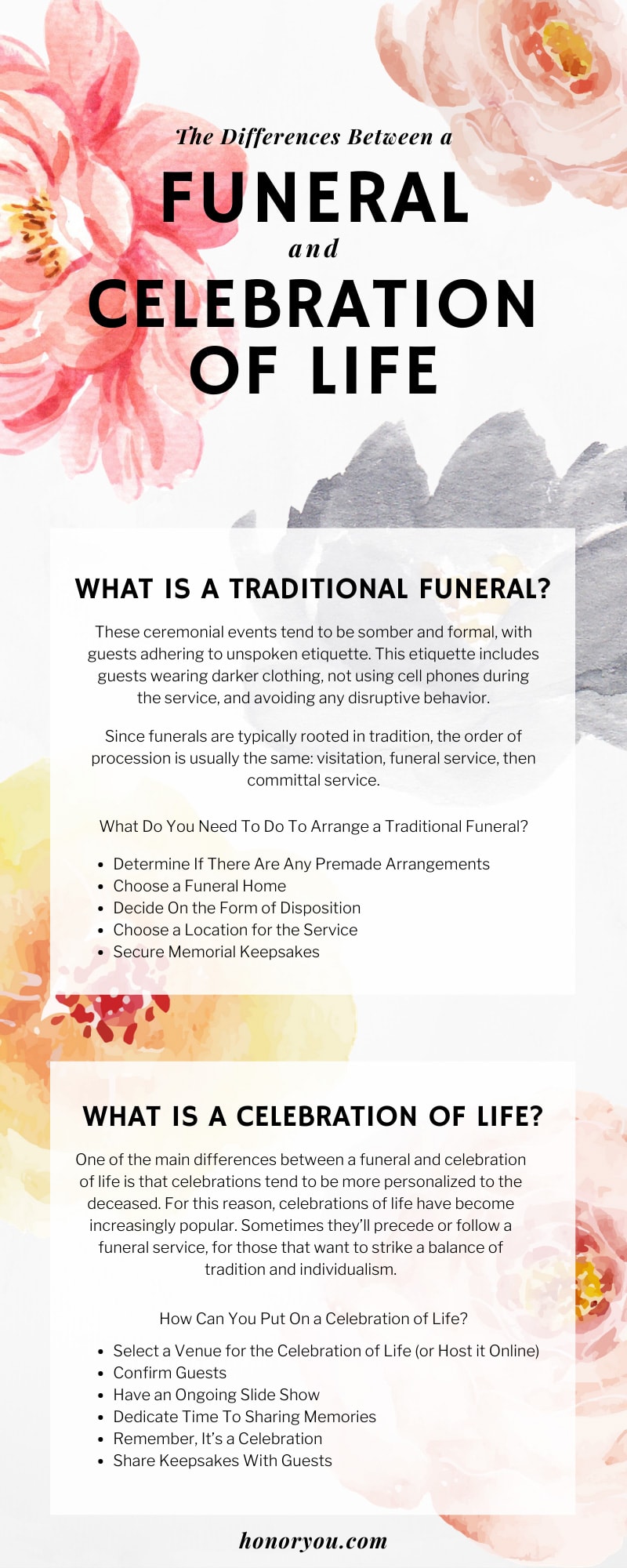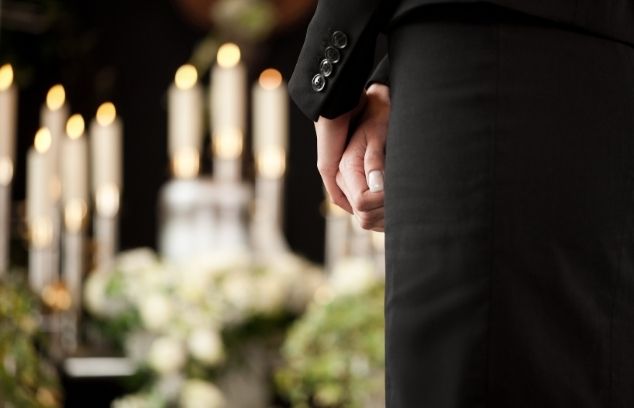The Differences Between a Funeral and Celebration of Life

Ideas for Celebrating a Deceased Loved One’s Birthday
March 31, 2021
Tips for Getting Through a Funeral Speech
April 20, 2021Traditional funerals and celebrations of life both serve as opportunities to commemorate a loved one’s time on earth. The differences between a funeral and celebration of life are primarily noticed through the tone, atmosphere, and varying logistics of the two. While a traditional funeral service is typically a bit more somber and melancholy, a celebration of life is just that – often vibrant and cheerful. Both commemorative services have their advantages and their shortcomings, as Honor You will explore in this article.
What Is a Traditional Funeral?
Most traditional funerals have religious themes—taking place at a church, containing scriptures and hymns, being led by a clergy member—but they certainly don’t have to. These ceremonial events tend to be somber and formal, with guests adhering to unspoken etiquette. This etiquette includes guests wearing darker clothing, not using cell phones during the service, and avoiding any disruptive behavior.
One of the perks to having a funeral is that the clergy member is often familiar with navigating themes of life and death. Family members of the loved one who are overcome with grief or afraid of public speaking can find relief in this speaker’s presence.
Since funerals are typically rooted in tradition, the order of procession is usually the same: visitation, funeral service, then committal service.
What Do You Need To Do To Arrange a Traditional Funeral?
Attending a funeral doesn’t quite give you the big picture of all the planning that goes into the arrangement. Discover all the steps required to organize a smooth traditional funeral service.
Determine If There Are Any Premade Arrangements
Some individuals make their funeral arrangements before passing. If you’re not sure whether your loved one has made any final arrangements, contact their legal representative.
Premade arrangements will give you guidance or instruction on decisions regarding the funeral service. If there’s no predetermined planning, you and your loved one’s will have to make the following choices on your loved one’s behalf.
Choose a Funeral Home
First, you’ll need to determine which funeral home suits your service needs. You’ll then schedule time to meet with the home’s funeral director. Funeral directors help families sort out services and ensure a proper ceremony. The direction should inform you about costs as necessary.
Decide On the Form of Disposition
If your loved one hadn’t decided before their passing, you’ll have to choose the manner of disposition. This is how the human remains are handled. Depending on whether you choose burial or cremation, you must then prepare accordingly.
Choose a Location for the Service
Funerals are commonly held at churches or other religious buildings but are not confined to them. You can have the funeral at a location meaningful to the deceased if desired.
Secure Memorial Keepsakes
Most funeral services have funeral service handouts for attendees to take with them. These keepsakes often display a photo of the deceased and serve as a visual reminder of their life. Usually, funeral handouts also include information pertaining to the order of service.
Additional Decisions for the Funeral
- Decide on a casket, burial Container, and/or vault.
- Schedule a clergy member or officiant.
- Purchase a cemetery plot and make grave arrangements.
- Select a grave marker.
- Prepare the obituary.
- Determine speakers and pallbearers.
- Organize transportation and reception.
What Is a Celebration of Life?
One of the main differences between a funeral and celebration of life is that celebrations tend to be more personalized to the deceased. For this reason, celebrations of life have become increasingly popular. Sometimes they’ll precede or follow a funeral service, for those that want to strike a balance of tradition and individualism.
A celebration of life is exactly that. It is essentially a party that recognizes the interests, achievements, milestones, and any other significant parts of the deceased’s life. As you would imagine, they are less formal than funerals, with looser dress expectations and a schedule that loosely resembles a funeral.
Celebrations of life look like family and friend gatherings with plenty of food and drinks, with time typically allocated to sharing cherished stories and memories of the deceased. The mood of these ceremonies tends to feel much brighter and joyous than grievous.
How Can You Put On a Celebration of Life?
If a celebration of life suits the deceased’s final wishes, here’s how to arrange one:
Select a Venue for the Celebration of Life (or Host it Online)
Decide where you’re going to have your celebration of life. Since this event is fairly informal, you can host it just about anywhere (within reason).
While folks may often hold the ceremony in their home or a restaurant, you can default to a large park or online video platform to make the event COVID-safe.
Confirm Guests
Relay all the necessary details to family and friends of the deceased. Getting an idea of how many guests can make it may influence where your celebration takes place.
Have an Ongoing Slide Show
To create some background ambience and showcase the deceased’s life through pictures, arrange a slide show. This gives guests the chance to see different phases and moments throughout your late loved one’s precious life and hear their favorite songs.
Dedicate Time To Sharing Memories
Open the floor for guests to share their favorite memory with everyone. To get the ball rolling, you can share a memory yourself. For those who don’t want to speak in front of others but still want to share a memory, you can set up a memory table. Here, guests can jot down a quick story and leave it for other family and friends to read and enjoy.
Remember, It’s a Celebration
Emotions are sure to arise during the celebration, but it’s okay to keep the tone of the festivities joyous. Stock up on your loved one’s favorite food, drinks, and music. Encouraging guests to wear everyday attire or something that reminds them of the deceased can help ease some tension, too.
Share Keepsakes With Guests
Keepsakes at a celebration of life may look different than at a funeral. You can still create custom handouts, but you may also find it appropriate to give away something of your loved ones.
If your loved one had collectible items or a plentiful library, consider redistributing the wealth to family and friends. What better way to extend an item’s shelf life than to give it to loved ones?
How To Decide Which is Right for Your Loved One
It can be difficult to make the decision between a funeral and a celebration of life while dealing with the grief of losing someone. Your choice should ultimately come down to what feels best suited to the nature of the deceased and what they would’ve wanted. If they appreciated tradition, you might find a funeral more fitting. If you have the time and resources, you can always experience both the sorrow of a passing and the joy of their life by doing both funeral and celebration.



